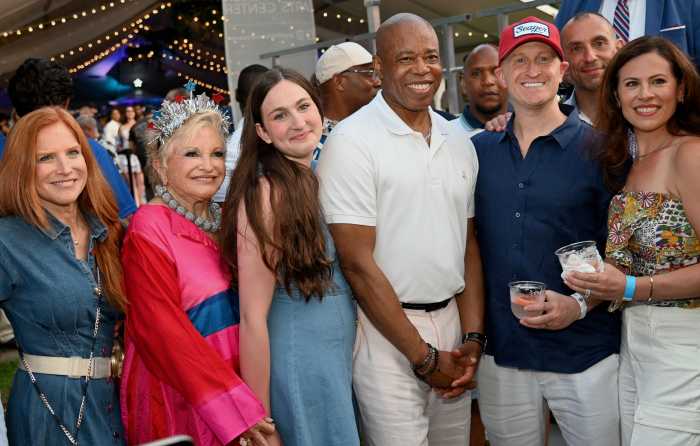
BY TRAV S.D. | Some names of the theatre deserve to have been forgotten; playwright Sidney Kingsley (1906-1995) isn’t one of them. Kingsley invented not one but at least three original genres of the stage and screen. His forte was to take a fascinating American subculture, obsessively research it, and then depict it on stage. In 1933’s “Men in White,” he gave the world its first “heroic doctors in a hospital” show, pioneering everything from “General Hospital” to “ER.” It was one of the few bona fide hits of the Group Theatre. In 1949’s “Detective Story,” Kingsley created the police procedural, blazing a trail that would lead to things like “Dragnet,” “Law & Order,” and “The Wire.” But the setting and characters of another of his Broadway smashes would come to have the longest shelf life of all: 1935’s “Dead End.” The Axis Theatre Company is reviving this forgotten gem at their home in Sheridan Square through May 20.
“Dead End” originally ran on Broadway for two years. Produced at the height of the Great Depression, it told of a group of poor, directionless, (and apparently hopeless) New York City street urchins, and some well-meaning adults who try to help them. It went on to become a 1937 Warner Brothers film starring Humphrey Bogart, Joel McCrea, Sylvia Sidney, and the kids from the original Broadway cast, including Leo Gorcey, Huntz Hall, Gabriel Dell, and others. Their popularity launched several successful comedy film franchises starring the kids under different names: the Dead End Kids (1935-1939), Little Tough Guys (1938-1943), the East Side Kids (1940-1945), and the Bowery Boys (1946-1958). In the intervening time, the world of the play evolved from one of hard-hitting social realism to one lowbrow slapstick comedy, featuring such plot devices as robots, genies, and mad scientists. Nowadays, that is what most people remember about the Bowery Boys. It is rare for audiences to have an opportunity to grapple with the original source material.
“I was obsessed with the Bowery Boys when I was a kid,” recalled the revival’s director, Randy Sharp, “and have been fascinated by them ever since. There’s something about these New York City street kids that’s very American. I’ve had the Bowery Boys make appearances in some of my past shows, like ‘Hospital’ ” (Sharp’s annual multi-episode experimental soap opera parody, which can ultimately also trace its lineage to Kingsley’s “Men in White”).
Ordinarily, Axis produces Sharp’s own original plays, but on occasion the company will take on an existing work and give it their own patented stamp. In the past, for example, they have done Georg Büchner’s “Woyzek” and Benjamin A. Baker’s “A Glance at New York.” Significantly, the latter play is a gritty 1848 gaslight melodrama about life among New York’s working class, not unlike “Dead End.” According to Brian Barnhart, Axis’ producing director, the company considered such plays as “The Philadelphia Story” and “Our American Cousin” (the play Abraham Lincoln was watching the night he was shot) before settling on “Dead End.”

With a cast of 14 (some Axis veterans and some newcomers), this is the largest cast production the company has ever presented. The original 1935 production had a cast of 35, when the economics of theatre were very different. The entire cast is onstage throughout the length of the show.
“One of the immediate challenges of ‘Dead End’ is how to deal with its iconic, stamped-out characters,” noted Sharp. “The hooker with the heart of gold; the snotty kid; the bad guy. In real life there is no such thing as a ‘Bad Guy.’ So who is that? Why does he talk like that? Maybe the Bowery Boys aren’t so cute. They seem to be enacting something dark and not very joyful. These are real children and adults living in tenements. Audiences were being exposed to the fact there was an unimaginable divide between rich and poor at the time, one even greater than there is now.”
Audiences less familiar with the Axis house style should know not to expect an “on the nose” production. What is on view will be quite different from what one might have experienced at the original play or film, or subsequent revivals in 1978, 1997, and 2005. While Kingsley’s original text (with some cuts) remains the framework, in Axis productions one often finds the moment-to-moment behavior of characters surprising and unpredictable, with motivations and line-readings not the obvious ones. For this reason, to this observer, Axis productions are never boring. Undergirding this production is a tapestry of live sound, organically devised by the cast through improvisation. Frequent Axis collaborator Paul Carbonara (of Blondie) is composing an original score at Sharp’s direction that will draw from Hollywood movie soundtracks.
One thing the Axis production will have in common with other theatrical versions and not the famous film, however, is a much franker treatment of language, references to sex, and depictions of violence and poverty, all of which were softened or expunged from the Hollywood film.
“In 1935 there was no Internet,” said Sharp. “Kingsley was using the theatre as a tool to literally educate people about conditions happening feet outside their door. It was a snapshot of real life during the Depression. The challenge is how to rediscover that now. Everyone has seen [images of] poverty and been inured to it. I want to reawaken them. How do we look at this again? I don’t want the audience to just sit back and let it skim over them. This is about a literal dead end, with no way out. These people still exist. We can’t dismiss them.”
“Dead End” runs through May 20: Wed. & Thurs., 7pm; Fri. & Sat., 8pm. Additional performances Mon., May 1, 7pm (official opening Wed., May 3). At Axis Theatre (One Sheridan Square, btw. Washington Pl. & W. Fourth St.). For tickets ($30 adults, $20 students, seniors; $15, artists & those under 30), visit axiscompany.org or call 212-807-9300.




























